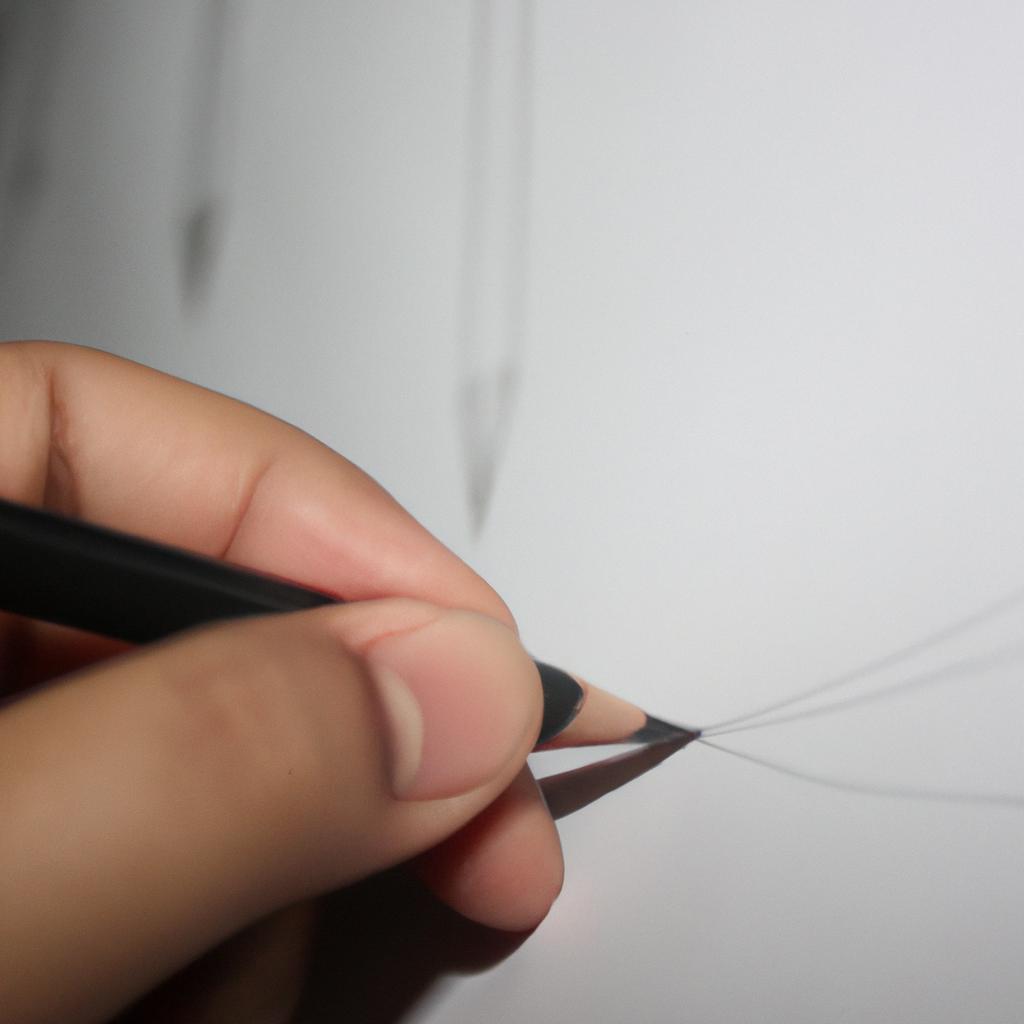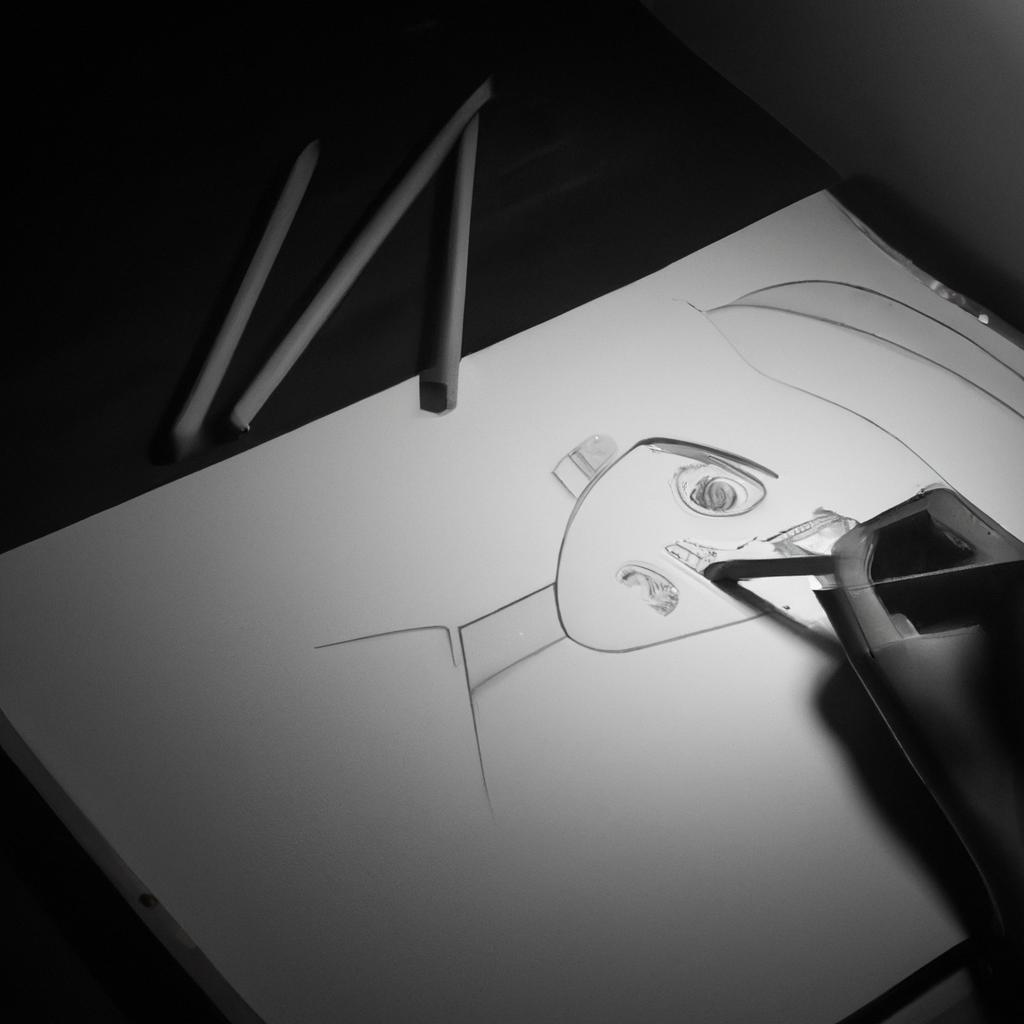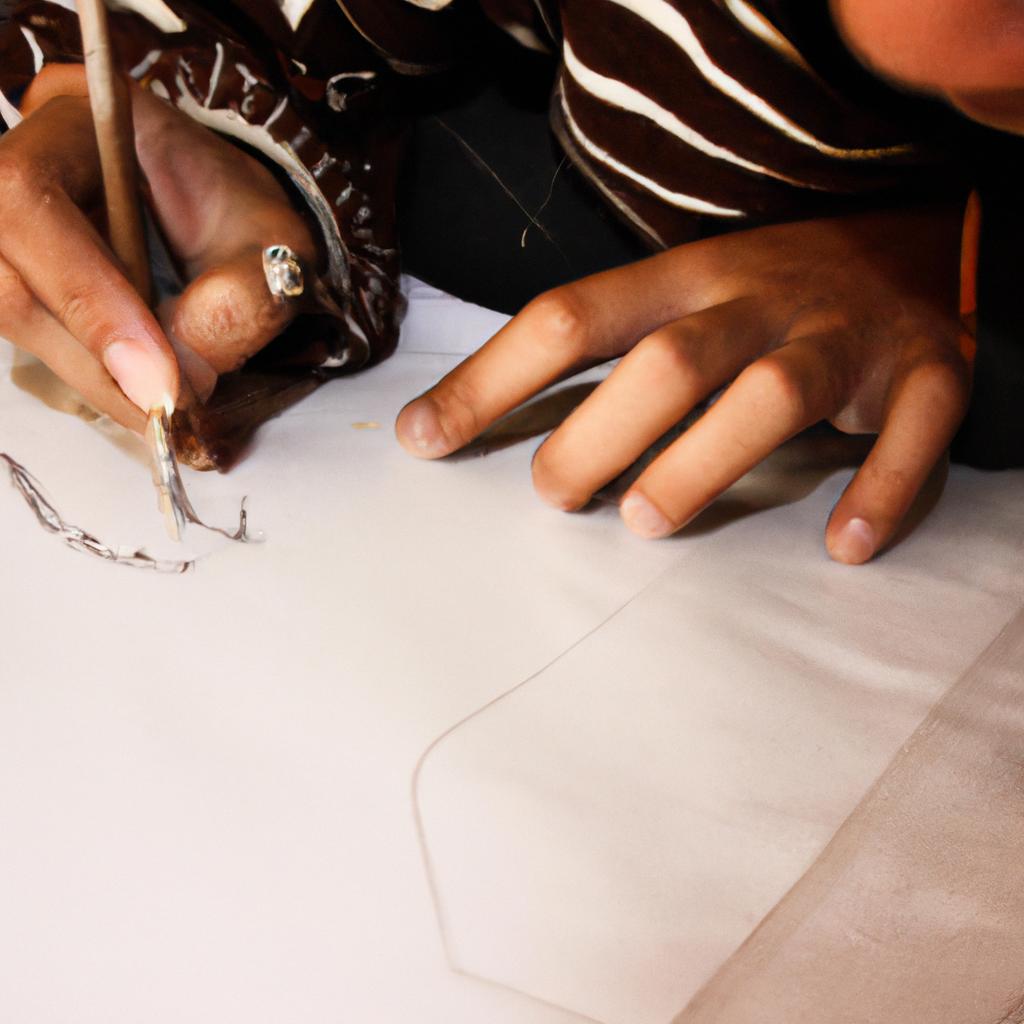The Importance of Line Weight: Visual Arts: Drawing

The importance of line weight in visual arts, particularly drawing, cannot be underestimated. Line weight refers to the thickness or thinness of a line created by an artist’s tool, such as a pencil or pen. It plays a crucial role in conveying depth and dimensionality within an artwork, influencing how viewers perceive and interpret the composition. For instance, consider a hypothetical case study where two artists create drawings using different line weights: one employs thick lines while the other utilizes thin lines. The resulting artworks would evoke contrasting emotions and impressions due to their distinct use of line weight.
In addition to affecting emotional responses, line weight also contributes to the overall aesthetic quality of a drawing. By skillfully manipulating line thicknesses, artists can enhance the sense of volume and form within their creations. A well-executed variation in line weight can give objects in a drawing more three-dimensionality and solidity, making them appear more realistic and engaging to viewers. Conversely, improper handling of line weight may result in flat and lifeless illustrations that fail to capture the essence of the subject matter. Thus, understanding and mastering the art of utilizing line weight is essential for any aspiring artist seeking to create visually captivating pieces that resonate with audiences on multiple levels.
Understanding Line Weight
Line weight is a fundamental aspect of drawing in the visual arts, playing a crucial role in conveying depth and adding dimension to artworks. By varying the thickness and darkness of lines, artists can create contrast, emphasize certain elements, and evoke specific emotions within their audience. To illustrate this concept, let’s consider an example: imagine a landscape drawing with thin, delicate lines used to depict distant trees and thick, bold lines employed for foreground objects such as rocks or buildings. This intentional variation in line weight not only guides the viewer’s gaze but also creates a sense of distance and perspective.
To further comprehend the significance of line weight in creating visually compelling artworks, it is helpful to explore some key aspects associated with its usage:
- Emphasis: By employing thicker lines, artists can draw attention to particular areas or subjects within their composition. For instance, using heavy lines on facial features in a portrait can highlight expressions or characteristics that are essential to capturing the subject’s personality.
- Texture: The use of different line weights allows artists to convey various textures effectively. Thin hatched lines may be utilized to represent smooth surfaces like glass or water while thicker crosshatching can simulate rougher textures such as tree bark or stone.
- Mood: Line weight can evoke emotional responses from viewers by influencing how they perceive an artwork. Bold and heavy lines often convey strength and power, while softer and lighter strokes tend to communicate delicacy and subtlety.
- Movement: The direction and thickness of lines contribute significantly to depicting movement within an artwork. Thick diagonal strokes might suggest speed or energy whereas fine vertical lines could imply stillness or calm.
| Aspect | Effects |
|---|---|
| Emphasis | Draws attention |
| Texture | Conveys materiality |
| Mood | Elicits emotional response |
| Movement | Depicts dynamism |
In conclusion,
line weight plays a vital role in the visual arts, enabling artists to convey depth and add dimension to their drawings. By incorporating varying line thicknesses into their compositions, artists can create contrast, emphasize certain elements or subjects, depict different textures, evoke specific moods, and even suggest movement.
Enhancing Visual Depth
Understanding Line Weight is crucial in the realm of visual arts, particularly drawing. By varying the thickness and darkness of lines, artists can manipulate the viewer’s perception and create a sense of depth and dimension. In this section, we will delve deeper into the significance of line weight and explore how it enhances visual depth.
One compelling example that showcases the impact of line weight is Leonardo da Vinci’s iconic drawing “Vitruvian Man.” The meticulous use of varied line weights allows for a distinct separation between different elements in the artwork. Thicker lines are used to define the outlines and contours of the figure, while lighter lines indicate less prominent details. This deliberate manipulation of line weight not only adds complexity to the composition but also guides the viewer’s focus towards specific areas or features within the artwork.
To further illustrate the importance of line weight, consider these key points:
- Visual Hierarchy: Varying line weights can establish a hierarchy within an artwork, directing attention to certain objects or areas over others.
- Depth Perception: Through skillful application of thick and thin lines, artists can create an illusion of depth on a two-dimensional surface.
- Emotional Impact: The choice and execution of line weight can evoke emotional responses from viewers by influencing their interpretation and engagement with the artwork.
- Expressive Possibilities: Line weight offers artists a wide range of expressive possibilities, allowing them to convey moods, tensions, or dynamics through subtle variations in strokes.
Let us now explore how various techniques involving line weight contribute to enhancing visual depth:
| Techniques | Description | Example |
|---|---|---|
| Cross-hatching | Overlapping parallel lines creating dark regions | Shading a three-dimensional object |
| Contour Lines | Outlines defining shape | Emphasizing facial features |
| Broken Lines | Discontinuous marks | Suggesting movement or energy |
By skillfully incorporating these techniques, artists can masterfully manipulate line weight to bring their creations to life.
Transitioning into the subsequent section about “Creating Emphasis and Hierarchy,” it becomes evident that mastering line weight is a fundamental aspect of artistic expression. As we delve deeper into the ways in which artists utilize this technique, we discover its ability to shape not only visual depth but also guide viewers’ attention towards specific elements within an artwork.
Creating Emphasis and Hierarchy
When it comes to creating art, one crucial aspect that artists often utilize is line weight. By varying the thickness or thinness of lines, artists can enhance visual depth in their drawings and add a sense of dimensionality to their work. Let’s explore how line weight contributes to this effect.
Imagine an artist sketching a landscape with mountains in the background, a river flowing through the middle ground, and trees in the foreground. By using different line weights, the artist can create a sense of distance and perspective. The mountains may be depicted with lighter, thinner lines to convey their distance from the viewer, while the tree trunks in the foreground could be drawn with heavier, bolder lines to emphasize their proximity. This simple example demonstrates how line weight can effectively establish visual depth within an artwork.
To further understand how line weight impacts perception, consider these key points:
- Line variation: Differentiating between thick and thin lines helps distinguish various elements within an artwork.
- Illusion of volume: Thicker lines suggest solidity and form, giving objects a three-dimensional appearance.
- Focal point manipulation: Utilizing heavier lines around certain areas draws attention and creates emphasis.
- Emotional impact: Varying line weight can evoke different emotions; bold strokes may convey strength or intensity, while delicate ones might represent fragility or subtlety.
To illustrate these concepts visually:
| Thick Lines | Thin Lines |
|---|---|
| Bold | Delicate |
| Strong | Subtle |
By incorporating both thick and thin lines strategically throughout a drawing, artists can engage viewers emotionally by directing their focus toward specific elements or conveying particular feelings associated with each stroke.
As we delve into the next section on portraying texture and form, let us now explore how artists use different techniques to bring life-like qualities to their creations without relying solely on color or shading alone.
Portraying Texture and Form
Creating Emphasis and Hierarchy in a drawing is crucial for guiding the viewer’s eye and conveying meaning. Now, let us delve into another essential aspect of visual arts: line weight. Line weight refers to the thickness or thinness of lines used in an artwork, and it plays a fundamental role in enhancing the overall impact of a composition.
To illustrate this concept, imagine a portrait where an artist has meticulously varied the line weights to emphasize certain areas. For instance, by using thicker lines around the subject’s eyes and lips while employing lighter strokes on less important elements like hair strands or background objects, the artist can draw attention to specific features and create a sense of depth within the piece.
Understanding how line weight contributes to visual impact is vital for artists seeking to evoke emotional responses from their audience. Here are some key ways in which line weight influences perception:
- Contrast: Varying line weights can establish contrast between different elements within a drawing, making them stand out from one another.
- Depth: By manipulating line thicknesses, artists can convey three-dimensionality and depth in two-dimensional drawings.
- Focus: Thick lines can direct viewers’ attention towards important focal points or subjects within an artwork.
- Implied Texture: Skillful use of varying line weights can create the illusion of texture, adding richness and complexity to a drawing.
In addition to these effects, incorporating line weight effectively requires careful consideration of its application throughout an entire composition. Artists often leverage techniques such as cross-hatching (the layering of intersecting parallel lines) or stippling (the creation of patterns through small dots) alongside varied line weights to further enhance their work.
By understanding the importance of line weight in creating emphasis and hierarchy, artists gain greater control over their compositions. In our next section on “Portraying Texture and Form,” we will explore additional techniques that build upon this foundation, allowing artists to express movement and energy in their artwork seamlessly.
Expressing Movement and Energy
Portraying Texture and Form in visual arts drawing is just one aspect of the many techniques that artists utilize to create compelling artworks. However, another crucial element that contributes significantly to the overall impact of a drawing is line weight. Line weight refers to the variation in thickness and darkness of lines used in an artwork, which can have a profound effect on how textures and forms are portrayed.
To understand the importance of line weight, let’s consider the following example: imagine an artist depicting a still life composition featuring various objects such as fruits, vases, and fabrics. By skillfully varying the line weight, the artist can effectively convey different characteristics of these objects. For instance, using thicker lines with more pressure applied by the hand might be employed to depict solid and sturdy objects like vases or wooden furniture. On the other hand, lighter strokes with thinner lines could be utilized to represent delicate materials like silk or fragile items such as ripe fruit.
The use of varied line weights offers several advantages for artists seeking to enhance their drawings:
- Depth and Dimension: Through utilizing heavier lines in areas closer to the viewer and lighter lines for elements farther away, artists can create an illusion of depth and three-dimensionality within their drawings.
- Visual Hierarchy: By employing thicker lines for focal points or main subjects while using thinner lines for secondary elements or backgrounds, artists can guide viewers’ attention and establish a clear hierarchy within their compositions.
- Emphasis on Details: Manipulating line weight allows artists to emphasize specific details or features within their drawings. Thicker lines may draw attention to important aspects while finer lines can capture intricate nuances.
- Expressive Impact: The deliberate choice of line weight can contribute to evoking certain emotions or conveying a particular mood within an artwork. Bold and heavy lines may impart strength or intensity, whereas light and delicate strokes might suggest fragility or tranquility.
Table: Examples of Line Weight Techniques
| Technique | Effect |
|---|---|
| Varying | Creates visual hierarchy |
| Thickness | Enhances depth and volume |
| Heavy | Adds weight and solidity |
| Strokes | to objects |
| Light | Implies delicacy |
| Strokes | or transparency |
In conclusion, the skillful manipulation of line weight in drawing plays a pivotal role in portraying texture and form. By effectively utilizing this technique, artists can establish depth, guide viewers’ attention, emphasize details, and evoke emotional responses. In the subsequent section on “Communicating Mood and Emotion,” we will explore how artists further employ various artistic elements to convey specific feelings within their drawings.
Communicating Mood and Emotion
Expressing Movement and Energy through line weight is just one way that artists can bring their drawings to life. By varying the thickness and intensity of lines, artists are able to create a sense of movement and energy within their artwork. For example, let’s consider a hypothetical case study: an artist drawing a figure in motion. By using thicker and more pronounced lines in areas where the figure is exerting force or moving quickly, such as the muscles or limbs, the artist is able to convey a dynamic sense of movement.
Line weight can be used strategically to communicate various emotions and moods within a drawing. The following bullet points highlight some ways in which line weight can evoke emotional responses:
- Thick, heavy lines can suggest strength, power, and boldness.
- Delicate, light lines can convey fragility, gentleness, and vulnerability.
- Quick, gestural lines can imply urgency, excitement, and spontaneity.
- Smooth, fluid lines can create a sense of calmness, serenity, and tranquility.
In addition to these emotional effects achieved through line weight variation, artists may also utilize techniques like cross-hatching or stippling to further enhance the overall impact of their work. These methods involve layering multiple thin lines or dots to create texture and depth.
To provide visual clarity on how line weight influences mood and emotion in artistry even further, we present the following table:
| Emotion | Line Weight Effect |
|---|---|
| Strength | Thick and bold |
| Fragility | Thin and delicate |
| Urgency | Quick strokes |
| Calmness | Smooth and fluid |
Through intentional use of line weight variations combined with other artistic elements such as color palette or composition choices, artists have the ability to elicit specific emotional responses from viewers.
Overall, it is evident that line weight plays a crucial role in communicating movement as well as evoking mood and emotion in drawings. Artists possess a range of techniques to manipulate line weight, enabling them to express energy, create dynamic compositions, and evoke various emotional responses from their audience. This skill is an important tool for artists seeking to engage viewers on a deeper level and effectively convey their artistic intentions.



